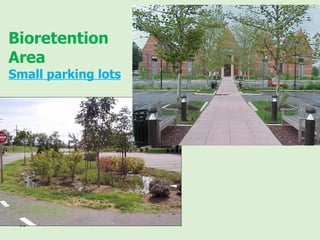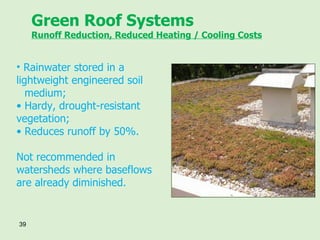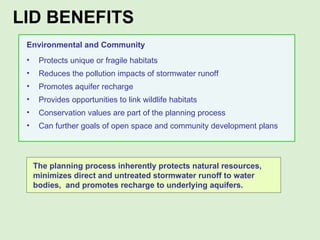Green Connection Lid 3 12 09
- 1. Sustainable Site Development: Land Development as Nature Intended Sustainable Urban Planning Policies Green Building Site Standards Low Impact Development Specifics
- 2. Michael Clark, PE, LEED AP www.westonandsampson.com Low Impact Development Specifics
- 3. A more sustainable land development approach Based on an environmentally sensitive site planning process; and A stormwater management strategy to mimic natural hydrology. An Introduction to LOW IMPACT DEVELOPMENT Alternative Approaches to Stormwater Management
- 4. Courtesy May, U of W Natural Conditions Hydrology 101
- 5. Courtesy May, U of W Developed Conditions Hydrology 101
- 6. WHY IS L.I.D. NEEDED? Maintain Natural Watershed characteristics Protect Recharge Areas and Ecological Integrity of Our Receiving Waters Control Water Quantity and Water Quality Restore / improve areas already developed An Introduction to LOW IMPACT DEVELOPMENT Alternative Approaches to Stormwater Management
- 7. Better site design: to identify and preserve natural features; to maintain natural hydrology; to help respect abutter’s properties; to retain property values; to augment groundwater supplies; to maintain high water quality. Local Authorities’ Perspective:
- 8. The Problem Conventional Development Smart Development Reduce land clearing and grading costs Reduced infrastructure costs Protect regional water quality Reduce stormwater runoff The Solution Impacts on open space
- 9. Conventional Development Centralized Pipe and Pond Controls
- 10. LID Development Conservation Minimization Soil Management Open Drainage Rain Gardens Rain Barrels Pollution Prevention Disconnected Decentralized Distributed Multi-functional Multiple Systems
- 12. LID Site Design Conservation of natural hydrology, trees, and vegetation Minimized impervious surfaces Dispersal of stormwater runoff Conservation of stream & wetland buffers Ecological landscaping
- 13. The standard planning process involves four-steps, after the yield is established. Source: R. Arendt
- 14. Identify conservation value areas on the site such as wetlands, significant trees or tracts of forest, steep slopes, habitat, cultural resources or buffer zones. Remove these from the “developable area”. 1. Source: R. Arendt
- 15. Place houses in the remaining area in a way that would maximize residents enjoyment of protected areas by providing access to open space and preserving views. 2. Source: R. Arendt
- 16. Align roads and trails on the site to provide pedestrian and vehicle access and maximize stormwater management options. 3. Source: R. Arendt
- 17. 4. Draw lot lines around the homes.
- 18. Reduce Stormwater Runoff, Treat Non-Point Source Pollution Site planning techniques (narrower roads, conserved natural areas, preserve natural depressions) Dry wells for rooftop runoff; Grassed (vegetated) swales; Filter buffer strips; Soil Augmentation; Bioretention areas; Permeable pavers; Green roofs; Rain barrels and cisterns; and Stormwater planters. LID Best Management Practices
- 19. Conservation Open Drainage Rain Gardens Amended Soils Rain Barrel Lot Level Source Controls LID Site Porous Pavement Create a Hydrologically Functional Lot Narrower Streets
- 20. Photo Copyright 1999, Center for Watershed Protection Many roads are much wider than they need to be. Better Site Design of Roadways & Parking Areas
- 21. Number of Accidents as a Function of Residential Street Width Source: Swift, et. al., 1998
- 22. Better Site Design of Roadways & Driveways Narrower streets Alternative cul-de sacs Shared driveways Source: City of Portland, OR Source: CWP Sarasota, FL
- 23. Better Parking Lot Design Green strips provide shade can use for stormwater collection & treatment reduce need for large unsightly detention enhance aesthetics Reduce overall parking create multiple small lots allow shared parking reduce space size Porous Pavement (in outlying overflow areas) Sarasota FL reduce runoff volumes & reduce pollution
- 24. Infiltration to replenish groundwater supplies and maintain baseflows to streams & wetlands; Less runoff and sediment to public drainage system = lower maintenance costs; PROBLEM : Downspouts Connected to Driveway = More Runoff, Less Infiltration OBJECTIVES :
- 25. SOLUTIONS : Dry Well Infiltration of Roof Runoff Rooftop Runoff to vegetated swale Source: CWP
- 26. Grassed Swales (aka “vegetated swales”) Provides better water quality treatment; Reduces infrastructure (drainage) costs; Reduces size and cost of detention basins; Is visible and affords better maintenance; Aesthetics may increase property values
- 27. Vegetated Swales Conveyance, Treatment, Infiltration Roadside swales (country drainage) for lower density and small-scale projects; For small parking lots; Mild side slopes and flat longitudinal slopes; Provides area for snow storage & snowmelt treatment
- 28. Bioretention (Biofiltration) Treatment, Retention, Infiltration, Landscaping Excavation filled with engineered soil mix Herbaceous perennials, shrubs, trees Ponded water infiltrates within 72 hours Overflow outlet and optional underdrain Source: CWP
- 29. Bioretention Treatment, Retention, Infiltration, Landscaping
- 30. Ref: Preliminary Sarasota County LID Manual, 2008 Bioretention Plan View
- 31. Soil / Flora / Fauna Ecological Structure A Dynamic Living Ecosystem Cycling Nutrients, Chemicals and Organic Energy Sources Plants, Bacteria Protozoa, Fungus Worms, Insects Mammals .
- 32. Bioretention Applications Parking lot islands Median strips Office parks Residential lots
- 33. Bioretention Area Small parking lots
- 34. Bioretention Applications Urban retrofits High-density areas
- 36. Grass pavers Paving stones Porous asphalt Pervious concrete Reinforced turf Permeable Paving Runoff Reduction
- 37. Permeable Paving Applications Parking stalls Overflow parking Driveways Walkways and plazas
- 38. Permeable Paving Applications Parking stalls Overflow parking Driveways Walkways and plazas
- 39. Green Roof Systems Runoff Reduction, Reduced Heating / Cooling Costs Rainwater stored in a lightweight engineered soil medium; Hardy, drought-resistant vegetation; Reduces runoff by 50%. Not recommended in watersheds where baseflows are already diminished.
- 41. Rain Barrels and Cisterns Runoff Reduction and Water Conservation Downspouts directed to tanks or barrels; 50 –10,000 gallons; Excess diverted to drywell or rain garden; Landscaping, car washing, other non- potable uses.
- 42. Rain Barrels and Cisterns Runoff Reduction and Water Conservation Large-Scale Applications
- 43. Stormwater Planters Runoff Reduction, Treatment, Attenuation “ Bioretention in a Box” Vegetative uptake of stormwater pollutants Pretreatment for suspended solids Aesthetically pleasing Reduction of peak discharge rate Source: City of Portland, OR Source: City of Portland, OR
- 45. Cohasset L.I.D. Stormwater Retro-Fit Project Lily Pond is Cohasset Drinking Water Supply Control of discharges to Lily Pond required to protect public health and ensure safe Drinking Water Supply
- 46. Cohasset Stormwater LID Project Project Goals Reduce Nutrient Loading Reduce Other Pollution Suspended solids, organic pollutants, oils Help Prevent Catastrophic Contamination Public Education / Demonstration Project
- 48. Demonstration Raingarden at Lily Pond Treatment Plant Designed to intercept flows from parking lot discharging directly to Lily Pond. To be used as a Public Outreach Tool to educate community. Planted with a mix of communities and age plants. Cohasset Stormwater LID Project
- 49. Site prior to excavation Cohasset Stormwater LID Project Demonstration Raingarden at Lily Pond
- 50. Biorentention Soil Mixing Cohasset Stormwater LID Project Demonstration Raingarden at Lily Pond
- 51. Excavation Cohasset Stormwater LID Project Demonstration Raingarden at Lily Pond
- 52. Underdrain Cohasset Stormwater LID Project Demonstration Raingarden at Lily Pond
- 53. Cohasset Stormwater LID Project Demonstration Raingarden at Lily Pond Graded Filter
- 54. Placement of Bioretention Soil Mix Cohasset Stormwater LID Project Demonstration Raingarden at Lily Pond
- 55. Planting June 2005 Cohasset Stormwater LID Project Demonstration Raingarden at Lily Pond
- 56. First Rain Storm Cohasset Stormwater LID Project Demonstration Raingarden at Lily Pond
- 57. September 2005 Cohasset Stormwater LID Project Demonstration Raingarden at Lily Pond
- 58. Environmental and Community Protects unique or fragile habitats Reduces the pollution impacts of stormwater runoff Promotes aquifer recharge Provides opportunities to link wildlife habitats Conservation values are part of the planning process Can further goals of open space and community development plans The planning process inherently protects natural resources, minimizes direct and untreated stormwater runoff to water bodies, and promotes recharge to underlying aquifers. LID BENEFITS
- 59. Benefits for Implementing at Local Level Eliminate or minimize large detention basins Reduce Infrastructure requiring town maintenance (reduced clearing, grading, paving, pipes, ponds) Improve water quality Reduce flooding Preserve natural features Encourage “functional” landscapes SWM controls become part of property owners’ landscape reduces public burden for centralized SWM facilities on-lot cost and scale of maintenance is affordable An Introduction to LOW IMPACT DEVELOPMENT Alternative Approaches to Stormwater Management


























































